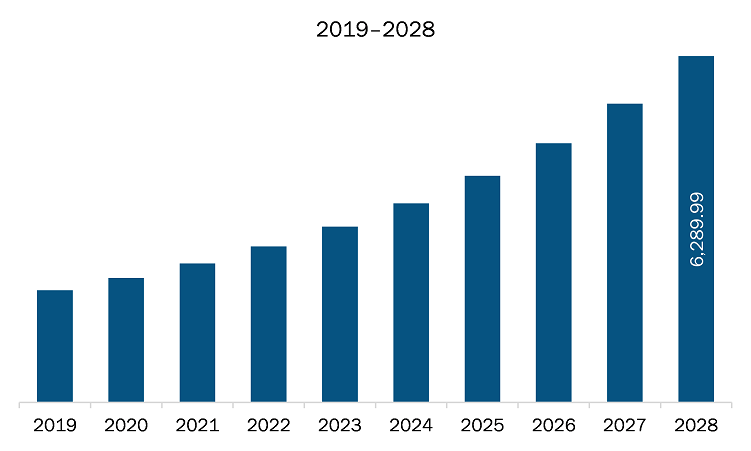The virtual event software market in Asia Pacific is expected to grow from US$ 2,523.10 million in 2021 to US$ 6,289.99 million by 2028; it is estimated to grow at a CAGR of 13.9% from 2021 to 2028.
Technological developments such as software-as-a-service based virtual events is generating a huge impact on the trend of conducting events virtually. The cloud-based tool allows the end user to provide interactive experience while enhancing overall sales experience through podcasting, instant messaging, and virtual product experience. Also, another Solution making a positive impact in the growth of virtual events is Connect through Live Streaming. Live streaming events enable larger number of participants to access content resources to assist them align with context better. Connect through live streaming is a process of streaming entire live video in real-time. The participants can enjoy presentations as live streaming are real and more authentic; unlike edited videos which feels distant and manipulated. For instance, companies such as Airmeet provides live video streaming in a HD quality with different engagement features such as group chat, Q&A, “social lounge with agenda”, and “raise hand”. The new product is accessible on any modern browser”. Hybrid Events is another aspect that would help in creating lucrative business opportunities for the growth of virtual events. The COVID-19 pandemic has transformed the event industry to assist planners and companies make better decisions utilizing virtual event Solution. As 2020 witnessed many virtual events, 2021 will observe a rise of hybrid events. Since vaccination is getting rolled up globally, it might become possible to commence with hosting in-person events. However, every attendee will not be comfortable with attending physical conferences and events so soon. Therefore, to assist in this case, hybrid events would play a positive role in boosting adoption of virtual event software. Hybrid events help the event planners to host event with limited number of physical attendees in one location and at a same time would give an online hub too for virtual attendees to take participation in events freely. Moreover, it is projected that over 65% of events professionals aims to utilize hybrid event format once in-person events start again. All aspects aforesaid about hybrid events and live streaming feature in virtual event software would help in accelerating the market growth.
The Asia Pacific region is hugely affected by a COVID-19, owing to a massive number of cases in China, the country is the most crucial manufacturer and industrial producer since it trades more manufacturing goods than any other country in the globe; it is also a world leader in several types of goods. According to the Organization for Economic Co-operation and Development (OECD), the other major economies outside of China have also impacted by the pandemic, such as huge South Korea, India, Australia, and Japan, and are experiencing downward growth. Since the outbreak of COVID-19 across the Asia Pacific, several countries have suffered heavily. China, Japan, South Korea, India, Hong Kong, and Taiwan are some of the countries that have incurred a huge loss. The manufacturing sectors in the countries mentioned above have been experiencing low production and a weak supply chain. Additionally, the labor shortage has affected the manufacturing sector in these countries. The work from home facilities across industries are foreseen anticipated to create demand for virtual event software. Hence, the overall impact of COVID-19 on Asia Pacific region is low to moderate.
With the new features and technologies, vendors can attract new customers and expand their footprints in emerging markets. This factor is likely to drive the Asia Pacific virtual event software market. The Asia Pacific virtual event software market is expected to grow at a good CAGR during the forecast period.

- This FREE sample will include data analysis, ranging from market trends to estimates and forecasts.
Asia Pacific Virtual Event Software Market Segmentation
Asia Pacific Virtual Event Software Market – By Solution
- Software
- Services
Asia Pacific Virtual Event Software Market – By Enterprise Size
- SMEs
- Large Enterprises
Asia Pacific Virtual Event Software Market – By End-User
- Trade Show Organizers
- Event Management Agencies
- Corporates
- Academic Organizations
- Others
Asia Pacific Virtual Event Software Market – By Country
- Australia
- China
- India
- Japan
- South Korea
- Rest of APAC
Asia Pacific Virtual Event Software Market – Companies Mentioned
- Hopin
- InEvent Inc.
- Pathable, Inc.
- Hubilo Technologies Inc.
- ubivent
- Cvent Inc.
- vFairs LLC
- Whova Inc
- Remo.Co
Asia Pacific Virtual Event Software Report Scope
| Report Attribute | Details |
|---|---|
| Market size in 2021 | US$ 2,523.10 Million |
| Market Size by 2028 | US$ 6,289.99 Million |
| CAGR (2021 - 2028) | 13.9% |
| Historical Data | 2019-2020 |
| Forecast period | 2022-2028 |
| Segments Covered |
By Solution
|
| Regions and Countries Covered |
Asia-Pacific
|
| Market leaders and key company profiles |
|
- Historical Analysis (2 Years), Base Year, Forecast (7 Years) with CAGR
- PEST and SWOT Analysis
- Market Size Value / Volume - Regional, Country
- Industry and Competitive Landscape
- Excel Dataset
Recent Reports
Testimonials
Reason to Buy
- Informed Decision-Making
- Understanding Market Dynamics
- Competitive Analysis
- Identifying Emerging Markets
- Customer Insights
- Market Forecasts
- Risk Mitigation
- Boosting Operational Efficiency
- Strategic Planning
- Investment Justification
- Tracking Industry Innovations
- Aligning with Regulatory Trends






















 Get Free Sample For
Get Free Sample For